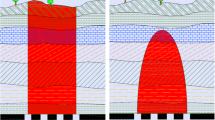Abstract
The hazards associated with the possible collapse of old mine workings underlying an active landfill site in north-east England have been identified as a significant concern to both the regulatory authorities and to the landfill operator. A quantitative assessment of the hazards and their perceived risks to the integrity of the composite lining system in place beneath the landfill has been undertaken using a combination of field observation, established mine subsidence prediction tools and numerical modelling techniques. Field observations have identified the presence of extensive fissuring within the limestone underlying the site, however, it is difficult to assess the extent to which mining has contributed to the development of these features. In light of this, an influence function technique has been used to attempt to predict the degree of fracturing that could have been experienced at the surface due solely to mining, with the intention of illustrating whether the scale of movements on pre-existing joints could be attributed to mining subsidence. The results of this analysis have subsequently been used within a finite-difference numerical model to assess the effect that a fracture of the scale predicted would have on the composite lining system.















Similar content being viewed by others
References
Anon (1959) Report on mining subsidence. Institution of Civil Engineers, London
Anon (2000) Report on the proposal by biffa waste services to deposit special (toxic) waste in houghton quarry landfill site. Residents against toxic site
Bekendam RF, Pöttgens JJE (1995) Ground movements over the coal mines of southern Limburg, The Netherlands, and their relation to rising mine waters. In: Land Subsidence: Proceedings of the Fifth International Symposium on Land Subsidence, The Hague, October 1995, IAHS Publ. No. 234, pp 3–12
Bell FG (1999) Geological hazards: their assessment, avoidance and mitigation. Spon Press, New York
Dixon N, Jones DRV (2003) Stability of landfill lining systems: guidance, environment agency research and development project P1-385, Report 2
Donnelly LJ (1994) Predicting the reactivation of geological faults and rock mass discontinuities during mineral exploitation, mining subsidence and geotechnical engineering. PhD Thesis, University of Nottingham
Donnelly LJ (1998) Fault reactivation and ground deformation investigation, Easington colliery, County Durham. British Geological Survey Technical Report WN/98/9
Donnelly LJ (2006) A review of coal mining induced fault reactivation in Great Britain. Q J Eng Geol Hydrogeol 39:5–50
Donnelly LJ, Rees J (2001) Tectonic and mining-induced fault reactivation around Barlaston on the Midlands Microcraton. Q J Eng Geol Hydrogeol 34(2):195–214
Donnelly LJ, Culshaw MG, Bell FG (2008) Longwall mining-induced fault reactivation and delayed subsidence ground movement in British coalfields. Q J Eng Geol Hydrogeol 41(3):301–314
Donnelly LJ, Siddle HJ, Northmore KN (2010) The origin of fault scarps and fissures on moorland plateaux and in the vicinity of landslides, in the South Wales Coalfield, UK. In: Proc. 11th IAEG Congress, Auckland, New Zealand
Dunham RK, Reddish DJ, Yao XL (1995) PC-Based computer package for mining subsidence prediction. Coal International pp 189–192
Goetz D, Roussel V, Tincelin E (1994) Cave-ins linked to mine flooding. 5th International Mine Water Congress, Nottingham, UK, pp 29–42
ITASCA (1995) Fast Lagrangian analysis of continua (FLAC). Version 3.3, Itasca Consulting Group, Minneapolis
Jaeger J, Cooke NG, Zimmerman R (2007) Fundamentals of rock mechanics, 4th edn. Wiley, New York
Jones DRV, Dixon N (2003) Stability of landfill lining systems: literature review, environment agency research and development project P1-385. Report 1:219
Kratzsch H (1983) Mining subsidence engineering. Springer, Berlin
National Coal Board (1975) Subsidence engineers’ handbook. NCB Publications, Hobart House
Pöttgens JJE (2000) Personal Communication
Reddish DJ, Yao XL, Dunham RK (1994) Risk assessment of structural damage due to mining subsidence—an integrated approach. In: Risk assessment in the extractive industries. Camborne School of Mines, University of Exeter
Ren G, Reddish DJ, Whittaker BN (1987) Computerised subsidence and displacement prediction using influence function methods. In: 7th Int. Conf. ground Control in Mining. West Virginia University, USA
Sheorey PR, Loui JP, Singh KB, Singh SK (2000) Ground subsidence observations and a modified influence function method for complete subsidence prediction. Int J Rock Mech Min Sci 37:801–818
Smith BD (1994) Geology of the country around Sunderland. Memoir of the British Geological Survey Sheet 21 (England and Wales)
Statham I (1951) Coal mining. English Universities Press, London
Tomlinson MJ (2001) Foundation design and construction, 7th edn. Prentice Hall, Englewood Cliffs
Wardell K (1954) Some observations on the relationship between time and mining subsidence. Transactions of the Institution of Mining Engineers, 113: 471–483 & 799–814
Whittaker BN, Reddish DJ (1989) Subsidence: occurrence, prediction and control. Elsevier, Amsterdam
Wigham D (2000) The occurrence of mining induced open fissures and shear walls in the Permian limestones of County Durham. Conference 2000: The legacy of mineral extraction. Institution of Mining and Metallurgy and North of England Institute of Mining and Mechanical Engineers, 18th–19th May 2000, Newcastle upon Tyne, pp 71–82
Young B, Culshaw MG (2001) Fissuring and related ground movements in the magnesian limestone and coal measures of the Houghton-le-Spring area, City of Sunderland: BGS Onshore Series Technical Report WA/01/04
Young B, Lawrence DJD (2002) Recent fissuring in the magnesian limestone at Houghton-le-Spring, City of Sunderland: BGS Survey Research Report RR/02/03
Yu MH, Jefferson I, Culshaw MG (2007) Fault reactivation, an example of environmental impacts of groundwater rising on urban area due to previous mining activities. In Proc. of the 11th Congress of the ISRM, Lisbon, Portugal, 9–13 July 2007
Acknowledgments
The author wishes to gratefully acknowledge the financial and technical support afforded by Golder Associates and the contributions made by the late Dr David Reddish to the original text of this paper. In addition, the author would like to express his gratitude to the anonymous reviewers for the helpful comments on this paper.
Author information
Authors and Affiliations
Corresponding author
Rights and permissions
About this article
Cite this article
Swift, G. Relationship between joint movement and mining subsidence. Bull Eng Geol Environ 73, 163–176 (2014). https://doi.org/10.1007/s10064-013-0539-7
Received:
Accepted:
Published:
Issue Date:
DOI: https://doi.org/10.1007/s10064-013-0539-7




